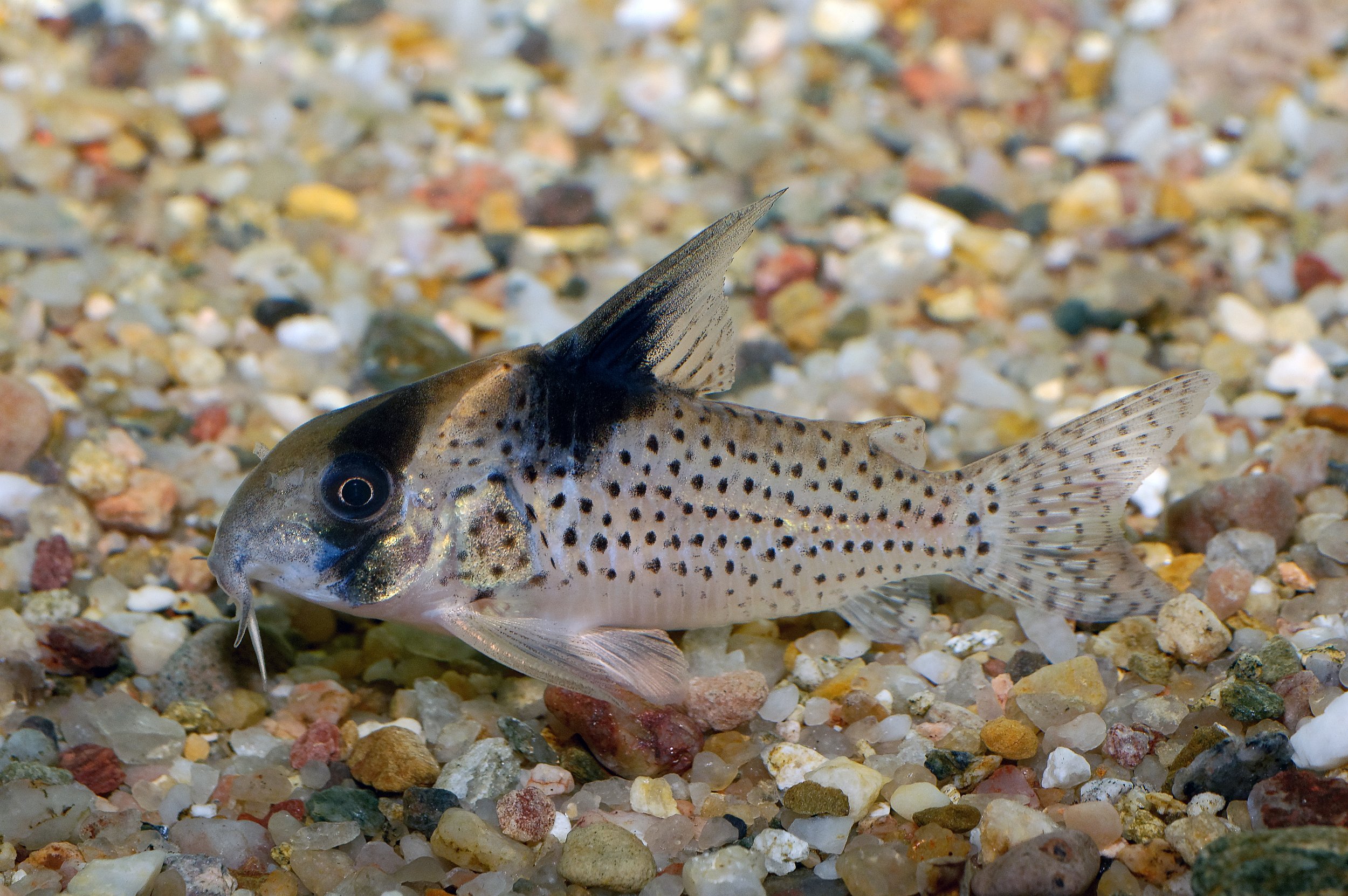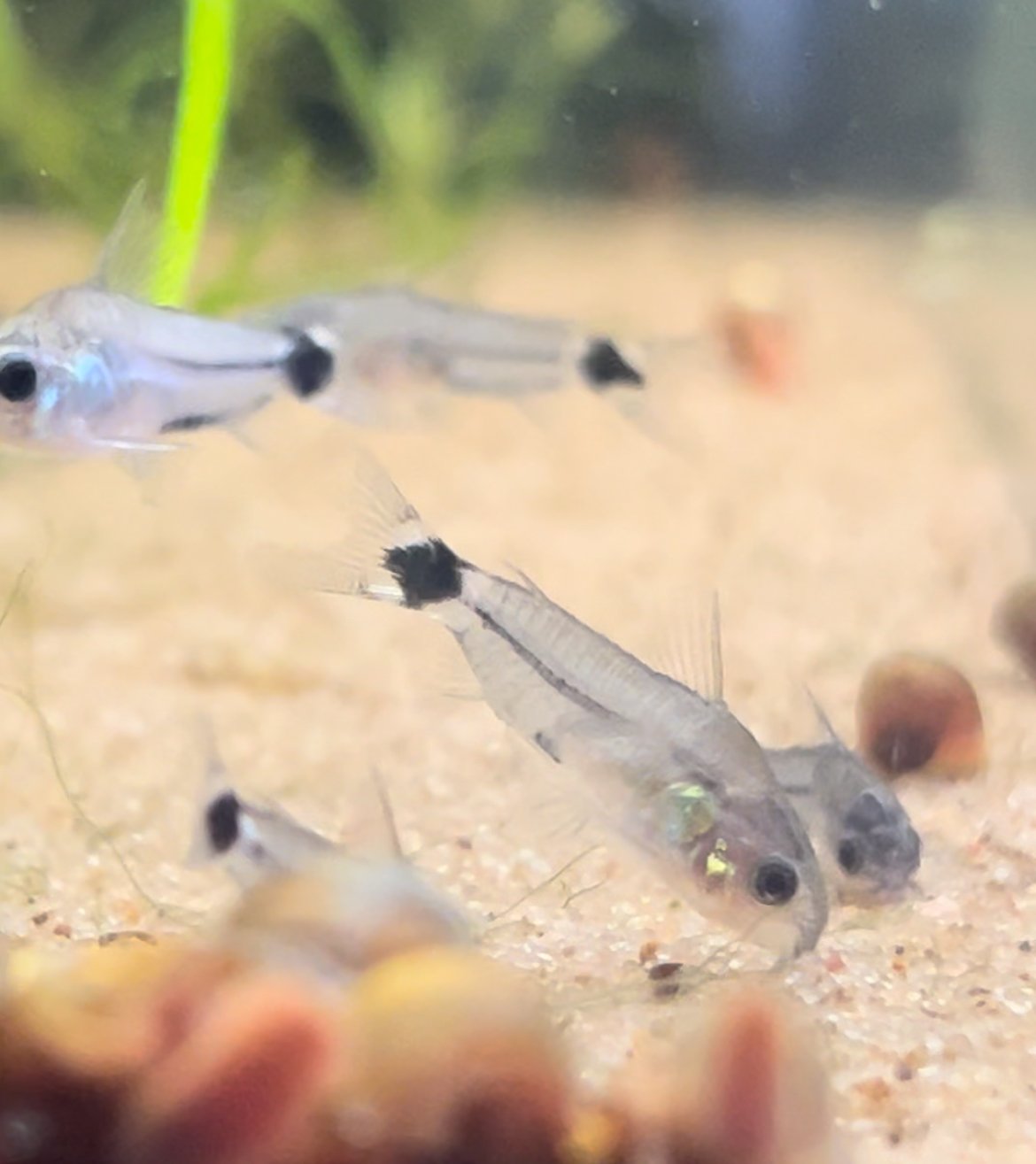 Image 1 of 2
Image 1 of 2

 Image 2 of 2
Image 2 of 2



Weitzmani Cory
The Weitzman’s Corydoras, scientifically known as Corydoras weitzmani, is a rare and visually striking freshwater catfish native to the cool, well-oxygenated streams of Peru. Highly sought after by Corydoras enthusiasts, this species stands out due to its bold pattern and active, social nature.
Physically, Corydoras weitzmani has a light tan to golden base color with three distinct black markings: a thick, mask-like black band covering both eyes and extending slightly onto the snout, a large black patch on the dorsal fin that extends partially down the back, and a bold black marking at the base of the tail, covering the caudal peduncle. The contrast between these dark patches and the lighter body coloration makes Corydoras weitzmani one of the most distinctive Corydoras species. The rest of the fins are mostly translucent, with some individuals displaying a faint smoky hue. Adults typically grow to about 2 to 2.5 inches (5 to 6.5 centimeters).
In the aquarium, Corydoras weitzmani thrives in groups of six or more, as they are highly social and feel more secure when kept in a shoal. A tank of at least 20 gallons is recommended, with a soft, sandy substrate to protect their delicate barbels. Providing plenty of hiding spots, such as driftwood, caves, and live plants, helps replicate their natural environment and allows them to exhibit natural behaviors.
Water parameters for Corydoras weitzmani should mimic their native habitat. They prefer cooler, well-oxygenated water with a pH range of 6.0 to 7.5 and temperatures between 68 to 75°F (20 to 24°C). A moderate to strong water flow is beneficial, as it replicates the currents of their natural Peruvian streams. Regular water changes and efficient filtration are essential to maintaining their health.
Feeding Corydoras weitzmani is straightforward, as they are omnivorous bottom feeders. They thrive on a diet of high-quality sinking pellets or wafers, supplemented with live or frozen foods such as bloodworms, daphnia, brine shrimp, and blackworms. Occasional vegetable-based foods, such as spirulina pellets or blanched zucchini, can provide additional nutrients.
Corydoras weitzmani is peaceful and makes an excellent tank mate for other small, non-aggressive fish. They coexist well with tetra species, rasboras, pencilfish, and other small Corydoras. Due to their preference for cooler water, they should not be housed with species that require consistently warm temperatures.
Breeding Corydoras weitzmani in captivity can be challenging but is possible under the right conditions. A cool water change (simulating the rainy season) often triggers spawning behavior. The female deposits adhesive eggs on tank surfaces such as glass, plant leaves, or decorations, and the male fertilizes them. The eggs hatch within 3 to 5 days, and the fry become free-swimming shortly afterward. The fry should be fed infusoria or powdered fry food, transitioning to baby brine shrimp as they grow.
Overall, Corydoras weitzmani is a rare and captivating species that brings unique coloration and lively behavior to freshwater aquariums. Their striking markings, social nature, and suitability for cooler water tanks make them a rewarding choice for dedicated aquarists.
The Weitzman’s Corydoras, scientifically known as Corydoras weitzmani, is a rare and visually striking freshwater catfish native to the cool, well-oxygenated streams of Peru. Highly sought after by Corydoras enthusiasts, this species stands out due to its bold pattern and active, social nature.
Physically, Corydoras weitzmani has a light tan to golden base color with three distinct black markings: a thick, mask-like black band covering both eyes and extending slightly onto the snout, a large black patch on the dorsal fin that extends partially down the back, and a bold black marking at the base of the tail, covering the caudal peduncle. The contrast between these dark patches and the lighter body coloration makes Corydoras weitzmani one of the most distinctive Corydoras species. The rest of the fins are mostly translucent, with some individuals displaying a faint smoky hue. Adults typically grow to about 2 to 2.5 inches (5 to 6.5 centimeters).
In the aquarium, Corydoras weitzmani thrives in groups of six or more, as they are highly social and feel more secure when kept in a shoal. A tank of at least 20 gallons is recommended, with a soft, sandy substrate to protect their delicate barbels. Providing plenty of hiding spots, such as driftwood, caves, and live plants, helps replicate their natural environment and allows them to exhibit natural behaviors.
Water parameters for Corydoras weitzmani should mimic their native habitat. They prefer cooler, well-oxygenated water with a pH range of 6.0 to 7.5 and temperatures between 68 to 75°F (20 to 24°C). A moderate to strong water flow is beneficial, as it replicates the currents of their natural Peruvian streams. Regular water changes and efficient filtration are essential to maintaining their health.
Feeding Corydoras weitzmani is straightforward, as they are omnivorous bottom feeders. They thrive on a diet of high-quality sinking pellets or wafers, supplemented with live or frozen foods such as bloodworms, daphnia, brine shrimp, and blackworms. Occasional vegetable-based foods, such as spirulina pellets or blanched zucchini, can provide additional nutrients.
Corydoras weitzmani is peaceful and makes an excellent tank mate for other small, non-aggressive fish. They coexist well with tetra species, rasboras, pencilfish, and other small Corydoras. Due to their preference for cooler water, they should not be housed with species that require consistently warm temperatures.
Breeding Corydoras weitzmani in captivity can be challenging but is possible under the right conditions. A cool water change (simulating the rainy season) often triggers spawning behavior. The female deposits adhesive eggs on tank surfaces such as glass, plant leaves, or decorations, and the male fertilizes them. The eggs hatch within 3 to 5 days, and the fry become free-swimming shortly afterward. The fry should be fed infusoria or powdered fry food, transitioning to baby brine shrimp as they grow.
Overall, Corydoras weitzmani is a rare and captivating species that brings unique coloration and lively behavior to freshwater aquariums. Their striking markings, social nature, and suitability for cooler water tanks make them a rewarding choice for dedicated aquarists.
The Weitzman’s Corydoras, scientifically known as Corydoras weitzmani, is a rare and visually striking freshwater catfish native to the cool, well-oxygenated streams of Peru. Highly sought after by Corydoras enthusiasts, this species stands out due to its bold pattern and active, social nature.
Physically, Corydoras weitzmani has a light tan to golden base color with three distinct black markings: a thick, mask-like black band covering both eyes and extending slightly onto the snout, a large black patch on the dorsal fin that extends partially down the back, and a bold black marking at the base of the tail, covering the caudal peduncle. The contrast between these dark patches and the lighter body coloration makes Corydoras weitzmani one of the most distinctive Corydoras species. The rest of the fins are mostly translucent, with some individuals displaying a faint smoky hue. Adults typically grow to about 2 to 2.5 inches (5 to 6.5 centimeters).
In the aquarium, Corydoras weitzmani thrives in groups of six or more, as they are highly social and feel more secure when kept in a shoal. A tank of at least 20 gallons is recommended, with a soft, sandy substrate to protect their delicate barbels. Providing plenty of hiding spots, such as driftwood, caves, and live plants, helps replicate their natural environment and allows them to exhibit natural behaviors.
Water parameters for Corydoras weitzmani should mimic their native habitat. They prefer cooler, well-oxygenated water with a pH range of 6.0 to 7.5 and temperatures between 68 to 75°F (20 to 24°C). A moderate to strong water flow is beneficial, as it replicates the currents of their natural Peruvian streams. Regular water changes and efficient filtration are essential to maintaining their health.
Feeding Corydoras weitzmani is straightforward, as they are omnivorous bottom feeders. They thrive on a diet of high-quality sinking pellets or wafers, supplemented with live or frozen foods such as bloodworms, daphnia, brine shrimp, and blackworms. Occasional vegetable-based foods, such as spirulina pellets or blanched zucchini, can provide additional nutrients.
Corydoras weitzmani is peaceful and makes an excellent tank mate for other small, non-aggressive fish. They coexist well with tetra species, rasboras, pencilfish, and other small Corydoras. Due to their preference for cooler water, they should not be housed with species that require consistently warm temperatures.
Breeding Corydoras weitzmani in captivity can be challenging but is possible under the right conditions. A cool water change (simulating the rainy season) often triggers spawning behavior. The female deposits adhesive eggs on tank surfaces such as glass, plant leaves, or decorations, and the male fertilizes them. The eggs hatch within 3 to 5 days, and the fry become free-swimming shortly afterward. The fry should be fed infusoria or powdered fry food, transitioning to baby brine shrimp as they grow.
Overall, Corydoras weitzmani is a rare and captivating species that brings unique coloration and lively behavior to freshwater aquariums. Their striking markings, social nature, and suitability for cooler water tanks make them a rewarding choice for dedicated aquarists.






